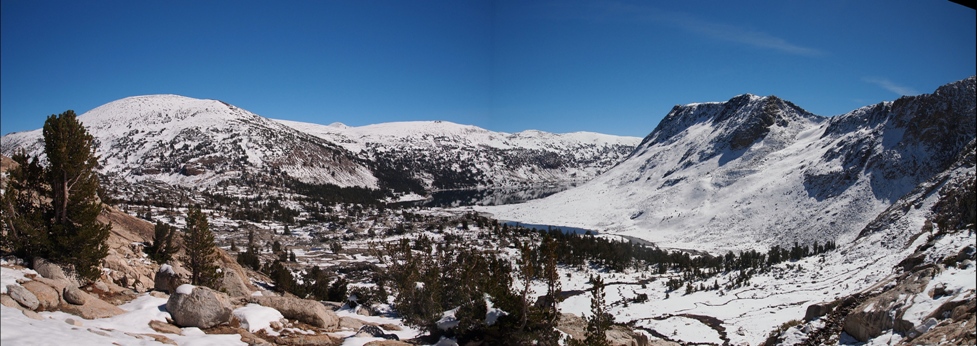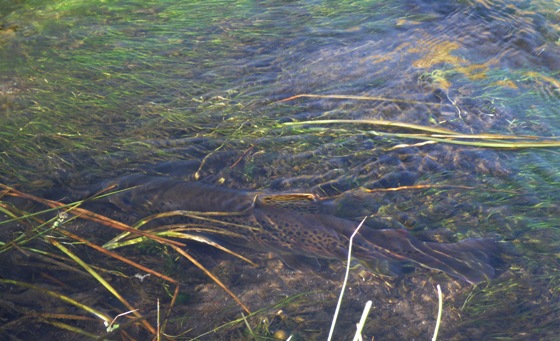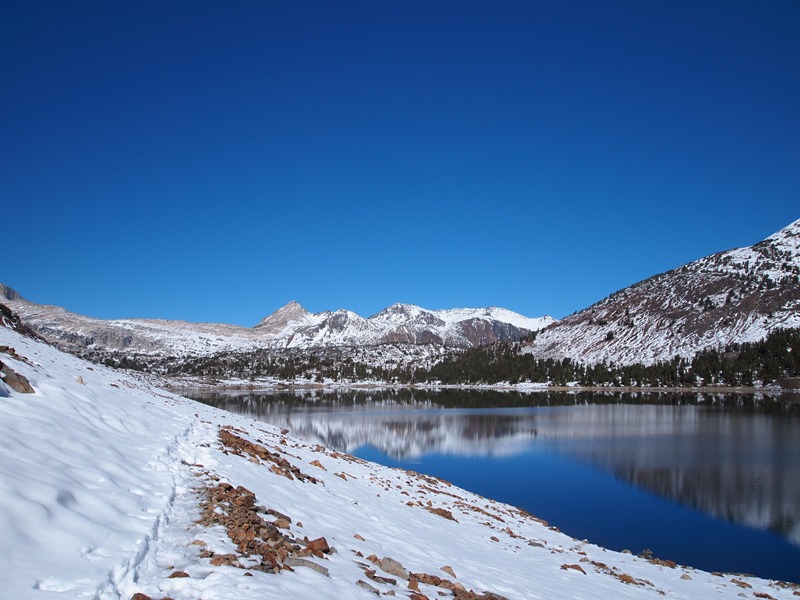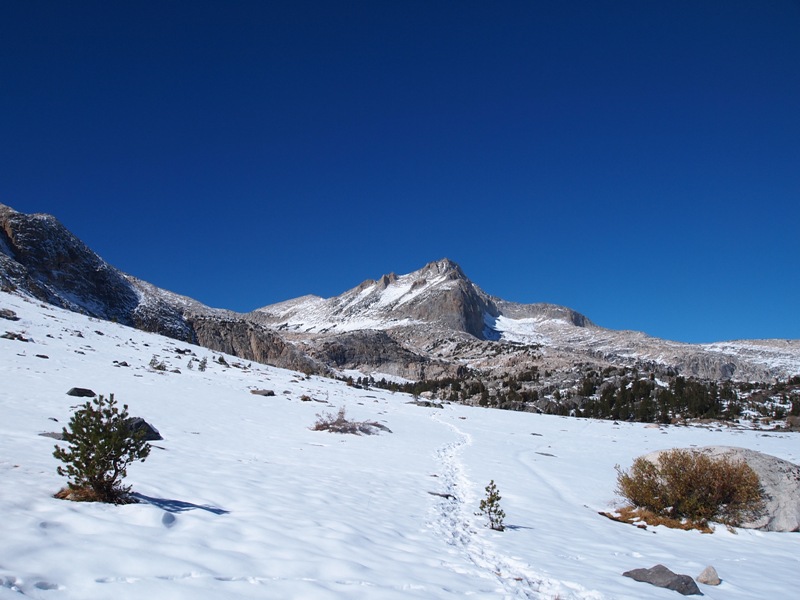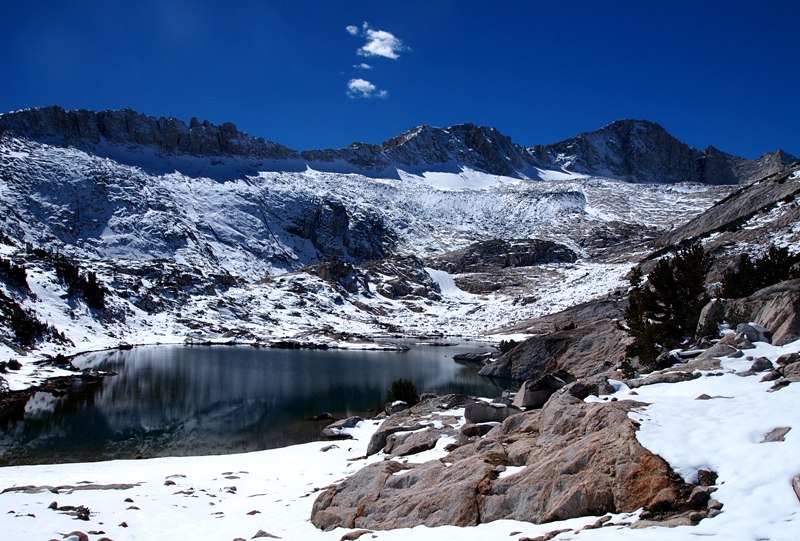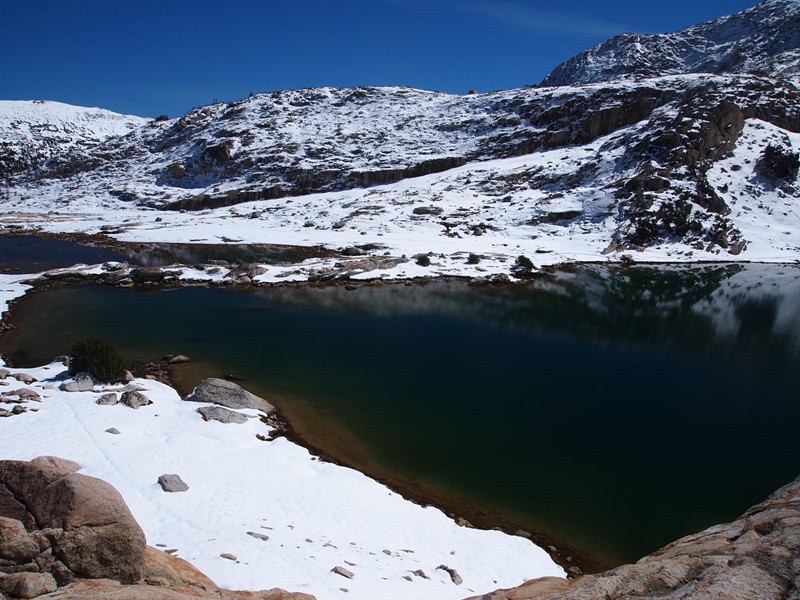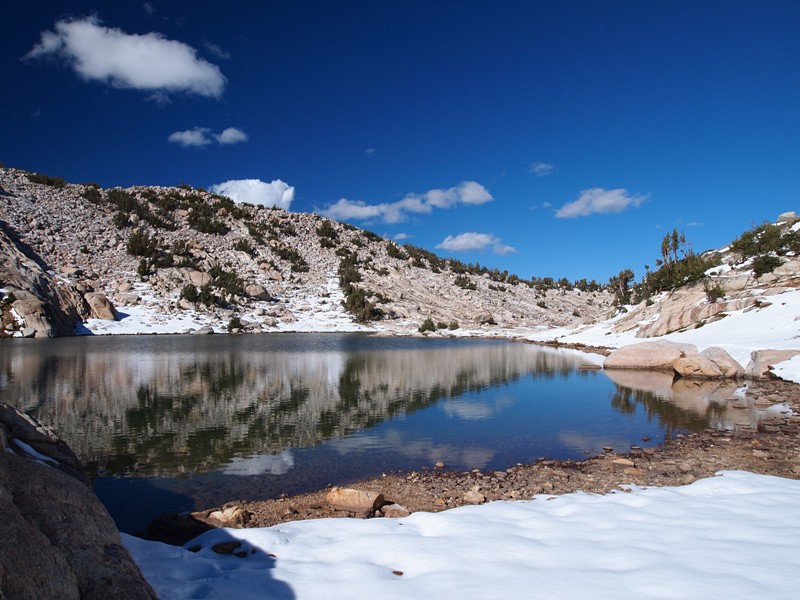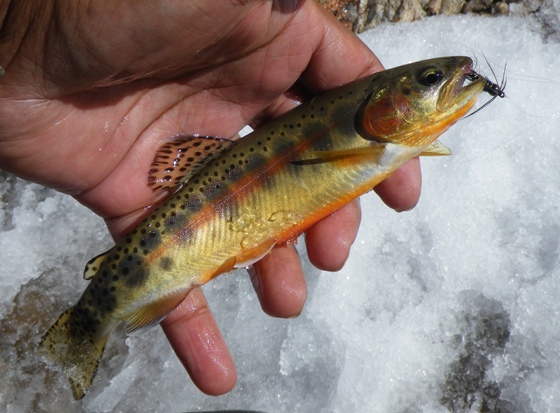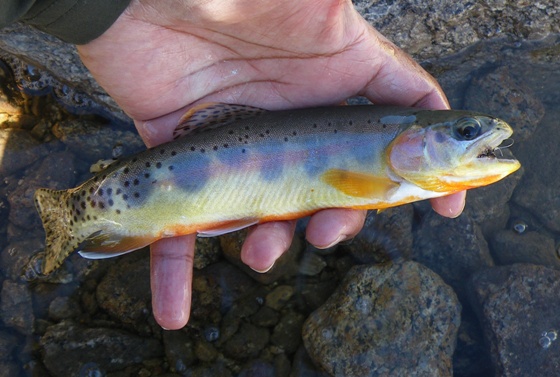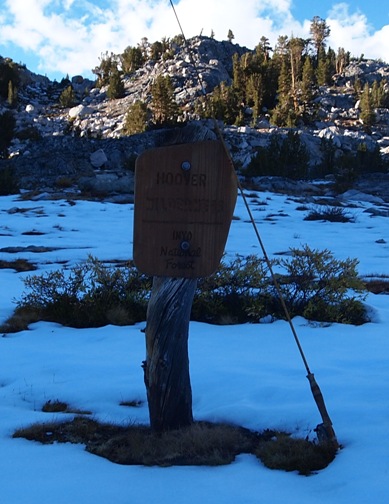|
|
|
|
|
October 2010- Hot Creek & 20 Lakes Basin Time:
12:30am - 4:30am Narrative:
Time flies. Itís hard to believe that itís been two months since I last fished. A sinus infection knocked me out for 3 weeks during prime September fishing time but I was finally able to rectify that this past weekend. Early snows had closed the passes last week and I left home early Friday morning not knowing what to expect. Iíd hoped to be able to get into the 20 Lakes Basin but there was the real possibility that the road was closed. The resort closed a couple of weeks ago and there was sure to be snow. I reached Yosemite Junction at about 6am and with Sonora Pass open, I was in Bridgeport by 8am. First stop- the Eastern Sierra Rod Makers Gathering. The Gathering is put on each year by Larry Tusoni and Chuck Irvine of High Sierra Fly Rods and Owens River Fly Rods. I cut out of the Gathering early in order to fish Hot Creek. I rarely fish Hot Creek this late in the season and with a 2 month lay off, it was more than appropriate for me to break the fast by fishing one of my favorite streams. Iíd heard that Hot Creek had been pretty crowded all year and that was definitely the case on this weekend. In fact, there was an angler about every 60 feet along my favorite section of stream. I was a little taken aback by this, I didnít think this place could get any more popular, but it has! The fishing wasnít as good as I thought it would be. I think the crowds and the weeds made it difficult. Thatís nothing new at Hot Creek but I know my flies werenít getting through the weeds fast enough. In many cases I could see the fishesí tails sticking out from under the weeds; I just couldnít get the fly to them efficiently. That didnít stop me from hooking into another solid fish like the one I hooked with Roger earlier in the year. When I set the hook, it felt as though I had hooked a rock, then said rock went flying downstream, nearly spooling me before it stopped. I pulled a rookie move by trying to put the fish on the reel when I should have simply been pulling line in and trying to catch up with him. It was exciting stuff though. The next morning I made my way over to Saddlebag Lake. The road was open but more severely rutted and wash boarded than Iíd seen it in the past. My 91 Corrola shook like a Monster Truck as I came careening off the pavement onto the muddy road. The snow covered the banks of Lee Vining Creek as well as the parts of the road. The upper portion of the road crunched under the weight of my tires as I pulled into the mostly snow covered parking lot. There were already several cars in the lot and folks fishing or float tubing Saddlebag Lake. I was amazed at how light my day pack felt and how fit I felt heading down the trail. I chalk that up to the 100 or so backpacking miles Iíve put in this year and the resulting loss of 20 lbs from my middle aged frame. I quickly navigated the fences and wooden walls by the dam and hit the trail into the 20 Lakes Basin proper. The trail starts off along a rock fall which is treacherous during the summer but was more stable with 8 to 24 inches of snow covering it. A trail of compacted snow had already been made by someone that obviously new the trail well. In a couple of not so compact places I would fall through the snow up to my knee but I was able to avoid injury. I followed this ďtrail of anotherĒ until the crossing at Greenstone Creek. From there I made my own way to the golden trout lakes. At these higher elevations much of what was left of a visible trail was muddy or covered in a small layer of ice, below which was Ö.. a mud puddle. The granite was also snow covered and slippery so I tried to place my foot falls to avoid the freezing puddles and wet granite.
This was the first time this year that I would be truly alone in the wilderness. On most trips I run into people eventually but not so this weekend. Once I left the parking lot I was solo all the way. It was just me, the foot prints in the snow, the wind and occasional rock falling of the high granite walls. I felt like I was the only person in the 20 Lakes Basin that day and itís possible that I was. There is a certain purity to fresh fallen snow anywhere but in the Sierra backcountry, covering the banks of a blue green glacial lake. Well, I have no words to describe the serenity I felt. Iíd been eager to fish these waters all year and so headed straight for far side of the lake where Iíd hooked large fish in the past. There was no trail in the snow to take me up and over the granite barrier protruding into the northern portion of the lake. Light foot falls and a few tricky maneuvers were required to traverse the rock fall at the base of barrier. Under the snow, some of unseen gaps between the boulders were large enough to fall into or trap a leg. Once past this hazard, I focused on the lake. From above, I could easily see some fish working the shoreline. I was moving too fast to care until it dawned on me I was leaving visible, working fish within easy casting distance to seek out unseen fish on a portion of the lake with unknown conditions. Iíd like to think that Mr. and Mrs. Lowe didnít raise a fool so I stopped and put on my favorite flying ant pattern. This fly had fished well here in the past. The largest trout I would see this day was working the near shore so I crept up to within ten or so feet from the water and laid out my first cast. The fish approached the fly slowly, hovered below it and then took a quick nip at the fly and turned away. I missed the strike. OK. I wasnít going to get the aggressive takes of the previous trip. Given the conditions, that really didnít surprise me. Typically this basin is very windy but this late in the season, at just past high noon, the water was as flat as glass. No hiding big leaders or imperfections here. The trout here seem to be fairly cooperative when it comes to striking at most flies but hooking them is another matter. I typically experience 3 types of takes on this lake: really aggressive, a confident slow rise or the quick nip. Until this trip, Iíd only experienced aggressive takes and nipping strikes but not the confident rise. Iíve experienced the nipping strike on most trips here. The nipping strike is a quick grab or near grab that seldom leads to a hooked fish. This seems to happen when the pattern is close but not quite right. The fish strike with an unsure nature of child trying to steal a cookie from a cookie jar before dinner. It better be done quickly so as to not get caught. Iíve had the aggressive strikes with big flies on choppy water. When the wind comes up and creates waves on the surface, this essentially creates cover for the fish and they feed a little more freely. They maybe harder to see but then so are you. Later, I would experience the slow, deliberate rise. A rise which was previously observed only when watching a fish take a natural off the water. The confident rise apparently only occurs with the perfect pattern, the pattern that closely matches the natural. Unfortunately, it would take me most of the day to figure out not what that pattern is but how to present it. The quick nipping fish kept me company most of the day. I chewed on my new favorite energy bar, the Peanut Butter and Jelly Lara Bar and watched the fish as it cruised the shore. It hadnít spotted me and would occasionally rise to a small yellowish orange bug. Iíve seen these bugs all over the sierra but havenít yet been able to catch one. If I ever do, watch out world! But until then, I donít really know what it is or how to imitate it. My best guess is that itís a midge or beetle of some kind. I cast my ant to intercept the fish as it swam away from me. The commotion on the surface drew itís attention. It made a cautious approach and hovered under the fly for a few seconds before making a quick strike at it. This fish wasnít getting its fingers caught in the cookie jar. I missed the strike.
I made another cast and the fish ignored the fly. No careless fish here. Iíve been told the short term memory of a fish is only 15 minutes but I wasnít going to wait that long to present my ant again. My next fly was a size 18 Parachute Adams, a decent midge fly in a pinch and small like the enigmatic natural. Unfortunately, it was apparently not small and midgey enough for the fish. It swam over, hovered under the fly for several seconds and turned away, disinterested. I switched flies again, going smaller yet again to a size 20 or 22 black gnat. I made the cast and the fish reacted as it did with the black ant and again I missed the strike. Another fish came into view and reacted in the same fashion, with a quick nipping strike. This time the disturbance of my strike sent both fish out of view. No problem, I had bigger fish waiting for me ďin the canyonsĒ. The canyons are simply the old river channel running down the length of the lake. I had good fishing over this channel last year and was hoping for the same this year. Of course fishing is never that predictable and the water was much lower than I expected. Last year was a low water year so I expected with this year being a high water year that the levels might be comparable, even though I was fishing 30 days later in the season. The so far windless lake made it easy for me to see into the water and just as easy for the fish to see me. They, for the most part, werenít holding over the channel as expected. There were some cruising fish an repeated casts to different fish resulted in the same ďcaught in the cookie jarĒ scenario. I had a problem which I didnít yet know how to remedy. My strike to hook up ratio was something like 20 to 0 by mid afternoon. I crossed the inlet stream and started working the opposite bank. This put my shadow on the water so I was very careful of my profile and while watching the rocky shoreline I noticed a bigger than average fish hiding under a rock. This was an important discovery. It seemed that the fish I expected to find over the channel were this day all hiding under rocks. I made few casts with a dry fly to a couple of rocks but it didnít seem enough to entice the fish to come completely out from under the rock to take the fly. The first fish I cast to made an almost a reflexive action of stick its head out from under the rock and drawing itself back under as if it said to itself ďwater low, leaving cover- bad!Ē No problem. On went the black bead head soft hackle fly. I dropped it within 3 inches of the rock and a trout rushed out and grabbed it. The reaction was much quicker than I expected and I missed the hook set. I chose another rock and repeated the presentation. Fish on! My first high sierra trout in almost 3 months!
The great thing about fishing in conditions like this is even if you donít catch fish, you get a great lay of the land. Low water means exposed structure and that helps one determine where to fish when the water is higher. I continued throwing the nymph at the rocks until I came to a deep section of the old stream bed. I was catching fish with the nymph but I was still getting the nippy strikes. In the open water of the channel I wasnít getting immediate reaction so I decided to put on a dry fly again. This time I put on a pair of dry flies a large Wulff type fly, which though I rarely use it, has done well for me this year, and the black gnat. The large fly is basically a Royal Wulff tied with black floss instead of red so it resembles a Captian fly. Itís purpose was to simply to help me spot the gnat. From the shoreline Iíd have to make a 40 foot cast to the deeper water and with the wind now throwing a ripple on the water, I needed a large visible reference. This was successful but I was still getting the nippy strikes, at both flies, and missing the hook set. I was convinced that this area would hold bigger fish and probably spent more time here than I should have. It was getting late and this left little time for me to effectively fish the rest of the lake. I quickly bypassed the really deep water on the south side of the lake. Making a few token casts with the nymph and moving on. I wanted fish the water were I had seen the cruising fish when I first arrived at the lake. Again the pattern continued- frustrating, nipping strikes. Iíd been watching the water all day and it was apparent to me that I simply didnít have the right presentation. The fish were taking the naturals confidently. No nipping strikes as was the case with my artificial flies. My fly was close enough to get the interest of the fish but I simply couldnít hook up. I tried slowing down my strike, speeding it up, using a tight line, using a slack line. Nothing worked. For all I knew, the fish were turning away at the last instant and not really striking at the fly at all. It was late afternoon before I finally got things right. Fall fishing means early sunsets and leaving the lake earlier than one might prefer. I had about 45 minutes of fishing time left if I was going to make the snowy hike back to my car before dark.. I went into troubleshooting mode. I was pretty sure that I didnít have it just right so I tried on a fly that was the same yellow orange color as the bugs Iíd seen trout after trout take so confidently. That didnít work. In fact, several casts to cruising fish elicited zero response. It was the same with a Sierra Bright Dot, a small Griffiths Gnat like midge fly with a red or in my case orange center. Back on went the gnat, up went the interest, no change to the hook up rate. Then it dawned on me that perhaps a slight modification of the fly might be in order. Iíd thought of this earlier in the day but put it out of my head. I wanted to catch fish with my flies just the way they had been tied. Not a very smart position to take but a day of more strikes than I can count with only two landed fish put me in a new mind set. I removed my clippers and made a few small modifications with to the fly. That was the ticket. On the first cast with the modified fly a fish approached with a smooth and confident head to tail rise and grabbed the fly. My line was tight and I very slow and simply lifted the rod tip. His take was smooth and my set was just as smooth. The 6 inch fish went bonkers. I released the fish and waited until another fish came into view. I spotted another fish and out went the cast. After a day of herky jerky, nipping strikes, I was finally getting confident takes and landing fish. The fish were so confident of the slightly modified fly that one actually broke of on the take. I made a cast just to its left as it was swimming away from me. The fly probably landed about 6 inches in front of it and the trout absolutely slammed it. How am I so sure that the modification made the difference? When the fish broke off I replaced it with a not quite modified fly and got the nipping strikes. I made a quick revision and I was back into fish. Itís amazing what a little modification will do to the effectiveness of a fly. Iíve had this strike and miss problem on this particular lake for years. Suddenly my strike to hook up ratio went from something like 3% to 95%- problem apparently solved. I played fast and loose with my time, leaving much later than planned but arrived back at my car with enough light to change cloths and put my gear away.
. Previous Hoover Wilderness Chronicle Next Hoover Wilderness Chronicle
|

